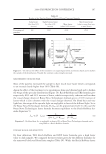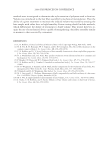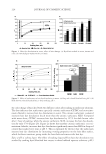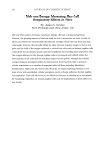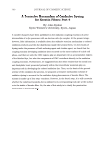2008 TRI/PRINCETON CONFERENCE 155 light travels through the hair fi ber, the chroma band is colored. Since this component is a refl ection, it appears as a band on the hair tress. The width of this band is greater than the width of the shine band because it experiences the surface roughness of the hair fi ber for one refl ection and two refractions. The chroma band is also shifted by the cuticle angle in the direction opposed to the shine band. O The last component is called the diffused light. It is caused by the light that is re- fracted into the hair fi ber and scattered by pigments inside the hair fi ber and other structural features of the cortex, like medulla. Since this component experiences diffu- sion, it is depolarized. Since the light travels through the hair fi ber, it is colored. Fi- nally, since it is caused by scattering, which is not a directive process, the diffused light does not appear as a band but as the background color of hair. PRESENTATION OF THE SET-UP A setup to measure independently polarized and unpolarized light component is de- signed. The setup consists of three main elements: a polarized illumination, a polarization Figure 1. Polarization set-up. Given the type of interaction with a sample, a polarized light will either keep its polarization if it is refelected off the surface of the sample or will be depolarized if it is scattered by the sample. Figure 2. Interactions of light with hair fi bers. The incident light on a hair fi ber can be either: refl ected by the surface of the fi ber, which creates the shine band, or refl ected after traveling through the fi ber, which cre- ates the chroma band, or scattered inside the hair fi ber, which creates the diffused light.
JOURNAL OF COSMETIC SCIENCE 156 camera and a cylinder on which the sample is positioned (Figure 3). Using both polariza- tion camera and polarized illumination allows the independent measurement of polarized light and unpolarized light. Combining a camera with a cylinder allows recording the angular distribution of the sample without any moving parts. Acquiring an angular distribution requires a change of geometric confi guration of the group illumination-sample-observation. This change of confi guration is created by the cylinder. The orientation relatively to the illumination direction and observation direction changes according to the point on the surface of the cylinder that is considered (Figure 4). The angle of the measurement is the angle between the direction of the specular light and the direction of observation. The angle between specular refl ection and direction of obervation is the type of angle measured in goniopho- tometers. Imaging setup has the advantage of acquiring images that can be used as a di- rect visual control of the numerical data. Images allow understanding better how a change of certain parameters like a darkening of the diffused light or reduction of shine band width affect the visual appearance of the sample. The use of both polarized illumination and polarization camera allows recording three types of images (Figure 5): O A normal intensity image representing what a human eye would see. O A specular image representing the light that is polarized. This polarized light shows only the refl ections (fi rst and second.) O A diffused light image representing the light that is unpolarized. This unpolarized light shows only the light scattered inside the hair fi ber. It is the background color of the hair. Diffused light and refl ections are physically separated without using any fi ts or mathe- matical decompositions. The computation of the angular profi les is done by averaging the images along the transverse direction (Figure 6). The system is angularly calibrated with its geometric properties so that the real angles are known for each line of the image. These angular profi les are similar to those provided by goniophotometers. From these profi les and images, relevant parameters characterizing the light distribution are computed. These parameters include: integral of the curve, maximum, width… Figure 3. (a) Optical setup of the polarization imaging system. (b) Commercial system.
Purchased for the exclusive use of nofirst nolast (unknown) From: SCC Media Library & Resource Center (library.scconline.org)














































































